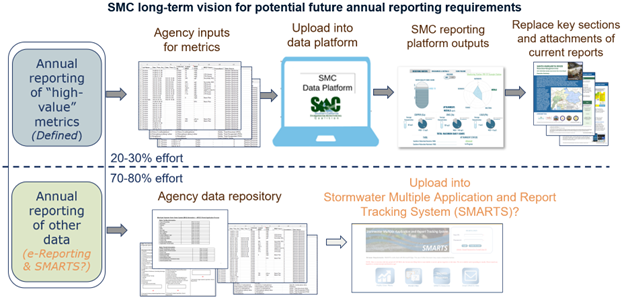The SMC has developed a proof-of-concept regional approach and web-based data platform to illustrate how Southern California’s stormwater management community could extract more managerially relevant insights from the water quality monitoring data that dischargers spend millions of dollars compiling each year under their stormwater permit reporting requirements.
The approach and interface, which was finalized in late 2023, enables municipal stormwater programs to input select data for identified “high-value metrics” from their routine monitoring and management activities via a web-based data platform. The monitoring results for the area are then compiled and presented in easy-to-understand, graphical formats.
Municipal stormwater programs can include the data compilations and visualizations in their annual reports to regulators, as well as share the data analyses with the public and civic leaders.
This type of proposed streamlining of the annual reporting requirements – along with development of regionally coordinated metrics for presenting insights about the health of water resources – is the first of its kind. The new data analyses are designed to complement – not replace – regulatory reporting requirements.

The goal of the SMC’s three-year Streamlining Annual Reporting project was to reach broad, regional consensus on how to more meaningfully communicate municipal stormwater programs’ progress each year in managing wet- and dry-weather runoff to protect water resources. Although stormwater dischargers are required under their National Pollution Discharge Elimination System (NPDES) permits to collect voluminous data sets, it can be difficult to identify key accomplishments and challenges from these data.
In developing the streamlined annual reporting approach, the SMC focused on an initial subset of “high-value” environmental-based and related program-based metrics that both regulated and regulatory parties agreed communicates relevant, insightful information about the health of regional water resources. The three categories of performance metrics that the SMC agreed to standardize and incorporate into its new data platform and user interface are: receiving water assessments, discharge assessments, and flow/volume assessments.
Already, some of the SMC member agencies have begun using the data platform to generate the data compilations and visualizations for use in their annual compliance reports. The data platform is currently only accessible to SMC member agencies while the agencies continue to gain experience using the platform.
The SMC views the data analyses and visualizations generated by the platform as a valuable complement to existing data reporting requirements that may be able to replace some permit-mandated reporting requirements in the future.
Dive deeper
SMC Spring 2024 Newsletter
Volume 4, Issue 3
This newsletter is published three times a year by the Southern California Stormwater Monitoring Coalition (SMC). To subscribe to this newsletter, contact inquiries@socalsmc.org.
